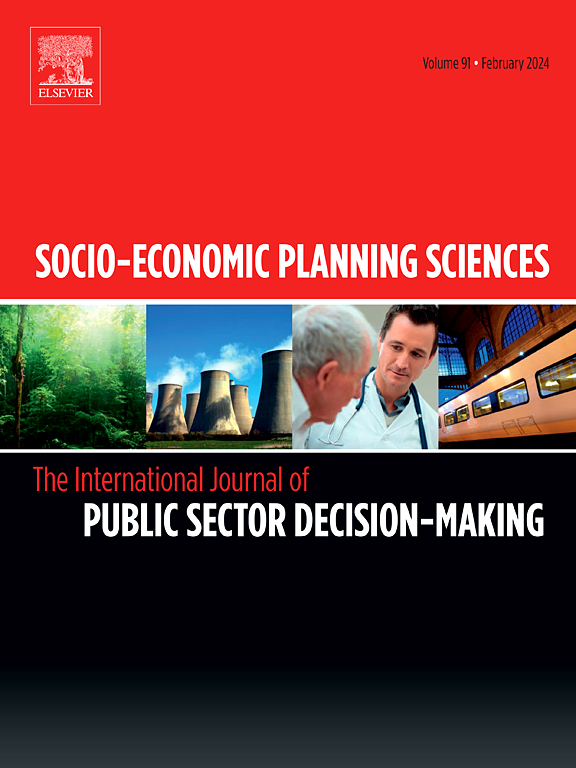通过集成无人机和警察巡逻加强公共安全
IF 5.4
2区 经济学
Q1 ECONOMICS
引用次数: 0
摘要
近年来,由于警力短缺和老龄化,台湾的警察部门一直面临着一个问题。在“空中警车”的概念下,政府和研究机构开发了具有更高续航力的无人驾驶飞行器(uav),结合先进的关键技术,以支持警察巡逻。这一发展旨在减少警察的工作量,并使未来通过使用警车和无人机的组合进行警察巡逻成为可能。针对警车和无人机的特点,采用时空网络技术,结合相关操作约束,以犯罪覆盖率最大化为目标,建立了无人机-警车联合巡逻的路径调度模型。此外,本研究提出一种启发式演算法,利用巡逻资源分解技术来有效解决这个复杂的问题。以台湾某警察部门的实际数据为例,对所提出算法的性能进行了评估,结果表明,对于具有9个警察局和91个巡逻点的大规模问题,所提出的算法在大约884秒内获得了最大累积犯罪覆盖率的客观值为906的解,而商业求解器(CPLEX)未能在28800秒的时间限制内找到可行的解。基于灵敏度和场景分析结果的建议,可作为决策者在未来逐步用无人机取代警车的参考。本文章由计算机程序翻译,如有差异,请以英文原文为准。
Enhancing public safety through integrated UAV and police patrols
The police departments in Taiwan have been facing a problem in recent years due to the shortage and aging of the police force. The government and research institutes have developed unmanned aerial vehicles (UAVs) with higher endurance, combined with advanced key technologies, to support police patrols under the concept of the “Aerial Police Vehicle”. This development aims to reduce the workload of the police and make it possible to conduct police patrols in the future by using a combination of police vehicles and UAVs. Given the characteristics of police vehicles and UAVs, this study adopts the time-space network technique, incorporates relevant operational constraints, and adopts the objective of maximizing crime coverage rates to develop the routing and scheduling model for combined UAV-police vehicle patrols. Additionally, this study proposes a heuristic algorithm that utilizes a decomposition technique of patrol resources to efficiently solve this complex problem. The performance of the proposed algorithm was evaluated using a case study created from practical data from a police department in Taiwan, demonstrating that for a large-scale problem with 9 police stations and 91 patrol points, the proposed algorithm achieved a solution with an objective value of 906 for the maximized cumulative crime coverage rate in approximately 884 s, while a commercial solver (CPLEX) failed to find a feasible solution within a time limit of 28,800 s. The recommendations based on the sensitivity and scenario analysis results can be used as a reference for decision-makers to gradually replace police vehicles with UAVs in the future.
求助全文
通过发布文献求助,成功后即可免费获取论文全文。
去求助
来源期刊

Socio-economic Planning Sciences
OPERATIONS RESEARCH & MANAGEMENT SCIENCE-
CiteScore
9.40
自引率
13.10%
发文量
294
审稿时长
58 days
期刊介绍:
Studies directed toward the more effective utilization of existing resources, e.g. mathematical programming models of health care delivery systems with relevance to more effective program design; systems analysis of fire outbreaks and its relevance to the location of fire stations; statistical analysis of the efficiency of a developing country economy or industry.
Studies relating to the interaction of various segments of society and technology, e.g. the effects of government health policies on the utilization and design of hospital facilities; the relationship between housing density and the demands on public transportation or other service facilities: patterns and implications of urban development and air or water pollution.
Studies devoted to the anticipations of and response to future needs for social, health and other human services, e.g. the relationship between industrial growth and the development of educational resources in affected areas; investigation of future demands for material and child health resources in a developing country; design of effective recycling in an urban setting.
 求助内容:
求助内容: 应助结果提醒方式:
应助结果提醒方式:


